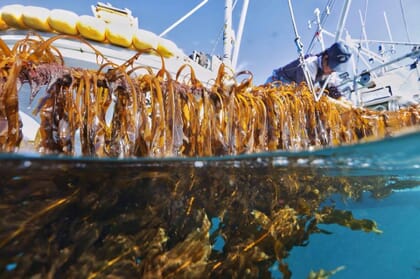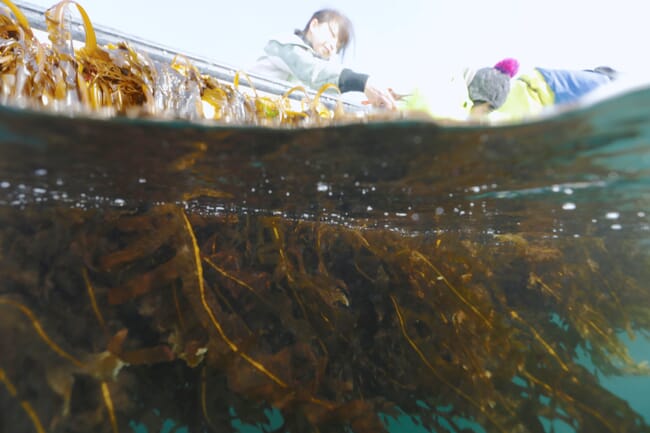Seaweed has been on Japan’s culinary map for centuries. In the eighth century, it was such a crucial part of people’s diets that legislation in 701 AD allowed them to use seaweed to pay their taxes. Today, the Japanese eat an estimated 9 billion pieces a year in food such as sushi and miso soup. In the Ryori district of Sanriku, a town in north-eastern Japan, the importance of seaweed is known only too well.
“It’s full of minerals, it grows fast and it has many uses,” says Shinichi Sasaki of the Ryori Fisheries Cooperative General Affairs Department. “It provides energy and shelter for marine species, cleanses the ocean and we couldn’t be in a better place to produce it.”

© Hiroshi Sato
Ryori is reaping the benefits of what’s known as a ria coastline – a jagged edge of long, narrow inlets with small bays that were formed through the gradual erosion of mountainous areas as rivers drained out to sea. The ocean has relatively low bacterial counts, while minerals wash directly off the surrounding cliffs, encouraging plankton to thrive.
The cultivation of wakame (Undaria pinnatifida) seaweed begins in Ryori when seed strings are kept cool under the summer thermocline or cultured in special aquaria over the summer. In autumn, when the sea surface temperature starts to decline, the strings are attached to longlines that are held in place by two concrete anchors on the sea floor. The sporophytes (blades) are harvested at around 2m long. The tops and bottoms are trimmed, and the rest is briefly blanched in seawater, cooled, mixed with salt and preserved in a saturated salt-water solution. The blades are then drained and left to dehydrate, after which the mid ribs are removed. After more dehydrating, the blades are checked for quality and packed. Kombu (Laminaria japonica) spores are transplanted to culture ropes in mid-January and lowered to deeper depths in April so the fronds lengthen. They’re usually harvested around late July.
“Seaweed production here is a good source of food for species like sea urchins,” says Hiroshi Sato, who leads a group of volunteer divers in Sanriku who are removing debris washed away by the earthquake and tsunami that struck Japan’s eastern coast on 11 March 2011. “We’ve seen various phenomena in the ocean recently, such as declining salt levels and changes in the current, and the sea floor has become quite barren with no natural food for sea urchins. Anything that drops off the strings is food for them.”
As the MSC-ASC seaweed standard gets underway, more eyes are turning towards areas like Ryori. The standard aims to highlight environmentally sustainable and socially responsible production of algae and to contribute to the health of marine ecosystems. However, the MSC Tokyo office has sensed a lack of progress in efforts to raise awareness.
“Aside from the seaweed standard, the MSC is not yet well known in Japan,” says Makoto Suzuki, fisheries manager at the MSC’s Tokyo office. “A consumer survey in 2016 showed that only 3 percent of Japanese consumers had seen the MSC ecolabel often, and 12 percent occasionally. Although we have approached industrial media and related groups, we still receive limited enquiries, and that includes [enquiries concerning] the seaweed standard.”

© Hiroshi Sato
Despite this lack of awareness, and a strong belief in Ryori that its seaweed production is socially and environmentally sustainable, Sasaki feels that if other areas such as product prices were looked at further, the district’s producers could be receptive to being assessed for certification.
“Very few people are aware of it,” he said. "But if it increases the price of products, makes them more widely known and allows seaweed producers to charge premiums, they may [become] interested. Harvesting seaweed is gruelling work, and I’m sure the standard would cover labour practices too. That’s an area we could change by working together.”
Kentaro Oikawa of the Ofunato Fisheries Promotion Center agrees that the price of seaweed products is key for producers, but doubts whether the standard would make a difference.
“Seaweed producers want the price of their products to rise,” he said. “But the consumers are key because they have an impact on prices,” he says. “Unless they become fully aware of the standard, understand its value and spread the word, I doubt prices will rise.”
Today, the Japanese market offers a range of seaweed products. These include salted or dried cut seaweed as well as soups and salads. Eaten in restaurants, fast food shops and instant noodles, seaweed is also being used to develop other items like snacks and powdered seaweed. But no single product or technique is particularly unique to Japan.
“Because we don’t know much about seaweed industries in other countries, it’s hard to say if what we have is unique,” says Sasaki. “In Ryori, we ship our seaweed raw, immediately after harvest, or boil it to produce a better colour and taste. We process big quantities in a rolling dryer as this gives us small pieces that can be packed easily. Less than 10 percent moisture is also retained, which is good for product stability during storage.”
Domestic tax hikes and competition from overseas have increased the amount of seaweed that Japan imports from countries such as South Korea and China. But others like Scotland and the US could one day become potential candidates.
“Unfortunately we have no information on those countries,” explains Oikawa. “But if there are seaweed species and products that aren’t found in Japan, and if consumers here can understand and appreciate their value, we may be interested in buying.”
“Imports from South Korea and China do affect the prices of domestically produced seaweed,” adds Sasaki. “So producers and distributors here keep a fixed eye on price fluctuations when it comes to those imports. We don’t have information on Scotland, the US and elsewhere, simply because we don’t import from them. It would be interesting to see how they would affect our prices.”
Western approaches
Although the West has never embraced seaweed with the same enthusiasm as Japan, the number of seaweed producers is on the rise and the Japanese love affair with seaweed is well known globally. Fiona Houston, co-founder and CEO of Mara Seaweeds, has been interested in the Japanese market since March 2017, when ten students and their teachers visited her company.
“We gave them a tour, and had a British-Japanese seaweed tasting session where we cooked together," says Houston. “We talked about Mara’s harvesting process and heard about the seaweed industry in their region. We can learn a lot from each other in areas like processing, drying, washing and technology. The students thought our work was very technically compliant with a huge focus on food safety, even more so than in Japan. But as much as I’d like to enter the Japanese market, it feels hard to get into. We would need a contact there, so looking for different approaches to cultivation and markets makes more sense for now.”

© Hiroshi Sato
Bren Smith, executive director of GreenWave and owner of Thimble Island Ocean Farm, agrees. Through his model of regenerative ocean farming, he aims to restore biodiversity and create jobs for fishermen while guaranteeing local, healthy food for communities. For Smith, farming seaweed makes economic sense. It’s a zero-input food that needs no fresh water, no feed and no arid land, and lots can be grown over wide areas. As for Japan, it’s firmly in his sights.
“Meeting Japanese seaweed producers is my dream,” he says. “There is a long tradition there with levels of markets and subsidies that we don’t have. But it’s an expensive country. Japanese scientists and academics that visit us are shocked at what we do, as if they don’t realise seaweed culture exists in the West. They do, however, bring some incredible knowledge, such as thinning crops so blades produced later in the year are larger, and how to ferment seaweed and hold it for years.”
But Smith doesn’t want to produce the same things as Japan. He views the sea as a major economic driver and job creator, and believes that it offers not only consumer products but also a chance for thousands of fishermen to work together, share infrastructure and use mother nature to build business and address issues such as climate change.
“I’d like to talk to Japanese people about what it means to be an ocean farmer, not just about production techniques or cultural aspects,” he says. “I’d like GreenWave to gather data, on the climate crisis for example, that Japan could gain useful insight from, and in turn they could share their knowledge with us.”
With a broader range of nutrients than land-grown vegetables, seaweed has been slipping into the mainstream for a while, and more countries are undertaking large-scale farming projects. Since it’s been hailed as a superfood, demand for this nutrient-rich plant is on the rise, which means that the future of the seaweed sector could be bright in both Japan and the West. Whether the MSC-ASC standard can play a pivotal role in that future remains to be seen.

